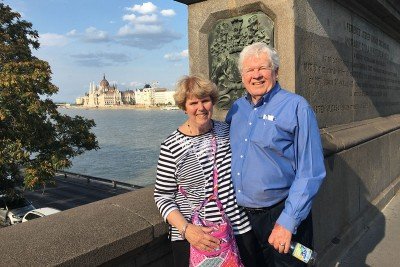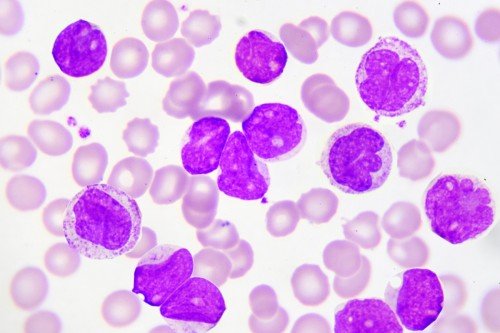After AML Relapse, a Clinical Trial Gives Dan a New Option
Dan Hussar was feeling fine after treatment for acute myeloid leukemia (AML). But when some unusual bumps on his skin turned out to be an AML relapse, the Philadelphia resident and pharmacy professor began to feel discouraged by his lack of options. That’s when Dan’s doctor suggested a clinical trial at Memorial Sloan Kettering. The trial was targeted to specific mutations found in Dan’s tumor, and the results seemed promising.

In September 2017, Dan and his wife celebrated their 50th wedding anniversary with a trip to Budapest, Hungary. During that trip, Dan met his new four-year-old granddaughter, whom his son and daughter-in-law were adopting.
- Dan Hussar completed treatment for acute myeloid leukemia (AML) at his local medical center in April 2015. By November, the leukemia was back.
- The treatment that worked for Dan the first time wasn’t likely to work again. His doctor recommended a clinical trial at Memorial Sloan Kettering.
- In December, Dan and his wife met with hematologic oncologist Eytan Stein, who explained what the trial would entail and shared some promising early results.
In April 2015, Philadelphia resident Dan Hussar, then 75, completed treatment for acute myeloid leukemia (AML) at a nearby academic medical center. “The therapy appeared to work, and I had been feeling fine,” he recalls. “Then in November, I began to notice these small bumps on my skin. They were almost like pimples.”
Dan’s doctor told him there was a slight chance the bumps could be leukemia and referred him to a dermatologist. A few days later, Dan’s worst fear was confirmed: The leukemia was back.
“It was discouraging,” says Dan. “There are so few drugs for AML, and my doctor didn’t think the medications that worked for me initially would be likely to work again.” Dan was looking at the prospect of intensive chemotherapy requiring hospitalization, which might not even be effective.
The good news was that the cancer had tested positive for an abnormality in the IDH2 gene. Dan’s doctor had recently learned of a clinical trial at Memorial Sloan Kettering studying a new therapy targeted to this very gene mutation.
Led by hematologic oncologist Eytan Stein, the trial was evaluating the safety and effectiveness of a drug called enasidenib for people whose AML had reappeared after initial treatment. Unlike other cancer drugs, enasidenib is not meant to work by killing cancer cells. Rather it is designed to rehabilitate cancer cells by helping them become normal functioning blood cells.
Dan decided it was worth a trip to New York.
Deciding to Join a Phase I Clinical Trial
“I first saw Dan in December 2015,” Dr. Stein recalls. “His relapse had appeared in the skin, but it was only a matter of time before the leukemia relapsed in the bone marrow. It was a serious situation. We were excited, though, because we had this drug that seemed very promising for people with the IDH2 mutation.”
The drug was being offered in a phase I clinical trial. Phase I trials are the first major step in testing a new drug in humans. In most cases, laboratory testing has already shown that the therapy in question may have some effect against a particular type of cancer. This was the case with enasidenib, but as Dr. Stein explained to Dan, there were no guarantees of success. “It’s really a leap of faith on the part of any patient who enters a phase I clinical trial. We are really grateful to people like Dan who choose to participate,” Dr. Stein adds.
As a professor of pharmacy, Dan knew a lot about medications, and he had some questions about the trial. Specifically, he wanted to know about side effects and whether there was a chance he would receive a placebo. Dr. Stein reassured Dan that the clinical trial didn’t use a placebo. “The vast majority of cancer drug trials don’t use placebos,” says Dr. Stein.
Side effects were a possibility, but Dan would receive close monitoring by a team of clinical trial experts. Dr. Stein shared with Dan some data that had already been reported at a large international cancer meeting, showing that people enrolled in the trial thus far had reported few serious problems.
Dan also liked that the drug came in a tablet form that he could take at home.
“Our Family Away from Home”
Dan was cautiously optimistic about the trial. He decided to join and began getting the drug in January 2016. Treatment consisted of a single oral tablet taken once a day. As a requirement of the trial, he would have to undergo an array of tests once a week for the first month to monitor his condition. These included a physical exam, blood draws, a bone marrow biopsy, and an EKG.
Those initial visits made for long days. Dan and his wife traveled to and from New York by car. But they found bright spots along the way. “I enjoyed getting to know the staff,” Dan recalls. “Dr. Stein and his colleagues became friends. The nurse who did my bone marrow biopsies, she has twins, and I have twin granddaughters, so we talked a lot about that. Those sorts of experiences made the difficulties tolerable.
“I can’t say enough about the caring and courtesy of everyone we met,” he adds. “People were encouraging, but not falsely reassuring. I really appreciated that. MSK became our family away from home.”
FDA Approval and Another Decision

Fortunately, the commitment very quickly began to pay off. Dan’s skin cleared up. Abnormalities that had begun to appear in his bone marrow went away too. After the first month of therapy, the visits to Dr. Stein dropped down to once every two weeks.
He was still doing well on the trial when, in July 2017, the US Food and Drug Administration approved enasidenib (Idhifa®) for use in people with relapsed AML with an IDH2 mutation. It was the first drug of its kind to be approved for cancer.
For anyone with relapsed AML who has the IDH2 mutation, FDA approval means that a new and effective treatment is now commercially available across the country. For Dan, FDA approval meant that he could drop out of the MSK study and receive enasidenib closer to his Philadelphia home.
At Dan’s next appointment, Dr. Stein asked him if he would consider staying in the trial so the team could continue to learn from his response to the drug. Dan agreed. “I was really appreciative of the good experience I’d had on the trial so far,” he says. “I also understood that there would be value not only for me but for others if I stayed in the trial.”
Life after an AML Relapse
After two and a half years on enasidenib, Dan is healthy and has experienced very few side effects. He has had some tingling in his feet as well as changes in taste. “Pizza and chocolate are less appealing than they once were,” he observes.
Dan and his wife continue to make the drive to New York every three months for follow-ups with Dr. Stein. “I still have the stamina for New York traffic,” he says, chuckling.
In June 2018, Dan retired from his teaching position at the Philadelphia College of Pharmacy. He’s quick to add that it wasn’t because of his health. “Retirement gives me more flexibility,” he says. “Most nights I’d stay at the office till after 6. Now we spend much more time with our children and grandchildren. We have been blessed in many ways.”
MSK’s President and CEO, Craig Thompson, is a co-founder of Agios Pharmaceuticals, the maker of enasidenib. Agios Pharmaceuticals has a financial relationship with Celgene Corporation. Eytan Stein has received grants and personal fees from Celgene Corporation and from Agios Pharmaceuticals. MSK physician-scientist Ross Levine, who collaborated on IDH2 mutation research, has received research support from Celgene Corporation.



